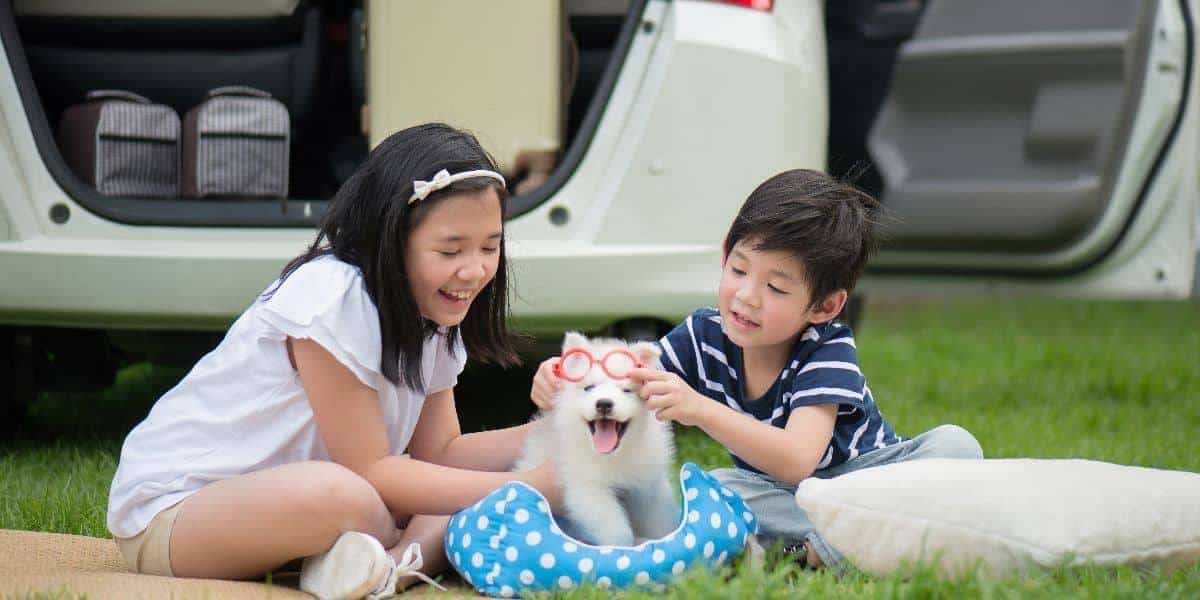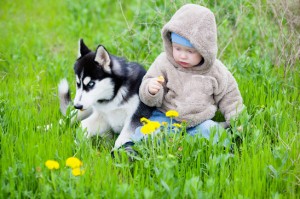
The Siberian Husky is a great family dog – not too large, active, and will put up with some rough play from children. A Husky’s natural behavior is to play, run, and be part of the “pack” – which will be your family.
The stories about the Eskimos who bred the Husky are the best evidence of how this breed relates to children. The birth of a child for these northern people is a big event, but a baby’s life is associated with various difficulties due to severe northern conditions.
Eskimos use their beloved dogs as nannies and a source of heat. They get the entire flock into their home and put the child between the dogs. And so the little Eskimo grows up surrounded by warm and friendly husky dogs.
Of course, for modern people living in warm and comfortable apartments, such excessive trust in dogs may seem strange, but this story clearly proves that children and huskies get along well with each other.
How to introduce a husky to a newborn baby?
If introducing a new baby to a home that already has a Husky, you want to be aware of potential jealousy issues. The Husky might have already been the “baby” of the house and could soon find itself having substantially less attention paid to him or her.
Weeks before the baby arrives you probably want to think about moving the Husky outdoors and away from constant attention. This will help the Husky get used to being alone a bit more, plus free up the house for all the “baby stuff” that is going to happen soon, including new furniture, playtime, visitors, sights, and smells. Gradually you can introduce the Husky to the new family member and make acquaintances.
Things to consider before introducing a Husky (whether puppy or adult) into your home, or before you bring a baby into a home that already has a Husky:
1. Supervision
You no doubt already know that children need to be supervised around dogs. This means watching them at all times, not just a glance every other minute.
In most cases, children up to 10-13 years old can not independently coordinate their actions in relation to the husky. Their behavior is often the opposite of what the dog considers polite.
Children are mobile, emotional and do not always understand what a pet may not like. Frankly speaking, the younger the child the more attention you need to pay. Kids and puppies are not aware of their size and strength and can hurt each other.
Young kids might think pulling the tail of the dog is funny, but the dog might not think so! You are going to need to keep a close eye on both and be prepared to jump in and separate them should play get too rough or either start to become agitated.
2. Responsibility
Even if your kids are aged a little older, say, early teens, the family pet is still ultimately the parent’s responsibility. After all, they are the ones buying the food, paying the vet bills, and often cleaning up afterward! A family pet can help teach responsibility to kids, but it isn’t a substitute for good parenting.
3. Allergies
If your kids have problems with allergies (or even if they don’t) you might want to see how they go around other dogs, or even go and get an allergy test. Huskies can shed a lot of hair which could trigger sneezing or other hay fever-like reactions. While no dog is truly hypo-allergenic (free from an allergic reaction), there are plenty of other dog breeds that are better suited if members of your family are sensitive to animals.
4. Exercise
Huskies need a fair bit of exercise to help them from becoming bored and destructive. Ask yourself if you are going to have time? Especially if you have young kids that need a lot of attention, is your Husky going to get the exercise he or she needs?
Are Siberian Huskies Aggressive Dogs?
The purebred Siberian Husky completely lacks aggression at the genetic level and it should not be any serious problems if you have a small child in your family. Huskies is a very smart dog with high intelligence and understands perfectly what is possible and what cannot be done in relation to a child.
Nevertheless, due to their size, you need to make a small adjustment to the behavior of the husky, so that its excessive playfulness does not hurt the child.
Unfortunately, the problem of aggression in dogs remains relevant and in most cases. we are the ones to blame for such behavior. Rude treatment, improper socialization, ignoring basic needs as well as lack of training, poor nutrition, social stress, including stress caused by poorly established rules of behavior for the dog can increase the degree of irritability and reduces their tolerance for attitude towards children. Let’s look at few examples below.
Things Your Child Should Never Do to a Siberian Husky
- Come too close to the husky bowl with food or take it away from the dog, while the dog is eating. Explain to your child that you can not approach the animal’s bowl when the husky is eating, as it might irritate the animal.
- Make sure that the child does not approach the husky frontally. Instead, ask them to turn their body slightly to the side. Your child should avoid bending over the dog’s face, not to touch roughly his head, legs, or back and not to shout in the dog’s face. Most dogs are comfortable being petted on the chest, the shoulders, and the base of the neck. When petting these areas, teach your children to reach in from the side, rather than moving the hand over the top of the dog’s head.
- Steal toys from the dog. Parents should make sure that the child and the husky do not use the same toys. To build tolerance when your child accidentally takes a husky’s toy, dogs can be trained to give up their toys for a reward or special treatment.
It might seem that with so many rules, it is very difficult to establish a good husky-child relationship. But it is not so.
Firstly, the dog perceives the child as a member of her family, as an integral part of it. Secondly, a husky who is well integrated into the family, seeks peaceful relations with the child, just as with other family members and relatives. To do this, husky tries to avoid conflicts, either trying to physically get out of unpleasant situations or to show some negative attitude to what is happening by means of reconciliation.
Any dog uses a number of signals to express its attitude to the world, and Siberian Husky is not an exception.
How to Tell if Your Husky is Uncomfortable?
- yawning
- licking nose
- turn away, sit down or lie down with its back turned to the child
- slowing down the movements or may completely freeze in place
If the child does not respond to these signals, the husky can begin to growl quietly. If the child ignores this signal, the dog growls more loudly, then its behavior becomes more aggressive and could even lead to a bite.
That is why parents must constantly monitor the way of how the child plays with a husky, and teach how to read the signals from the dog to know when to stop and leave your Husky alone for a while.
Tips to help establish contact between the child and the husky
- Socialize your husky at the early stage. Make sure you get your husky puppy out on the street. It will help him to adjust and expose to a wide range of noises and behaviors. Allow him to interact with people and other dogs, so he would gain confidence at the earliest stage of his life and it would become normal for him.
- Allow your children to treat husky with treats. Let the child also take part in the care, training, education of a husky puppy. The feeding process strengthens friendships and is even included in the canister therapy program. As a result of feeding, the dog and the child will begin to trust each other more.
- Teach your dog a basic commands (“Stop”,”Sit”, “Come”), endurance. Regulate the state of rest and activity, do not subject the dog to stresses, emotional experiences in order to avoid the mental disorders of the pet. It is best to take a training course with a dog handler. I found Doggy Dan’s online training techniques and philosophy are the best fit for our Siberian Huskies. You can sign up for a 1$ trial for 3 days and see if you like it.
- Exercise your husky on a regular basis. They are very energetic dogs and lack of exercise could lead to naughty behavior and frustration (jumping, chewing), which might be a problem if you have a small child in the house.
- Never let your child play rough with the husky. Even though husky are super friendly, do not allow your child to poke, pinch, pull on their hair, or play aggressive games with them. Children are very mobile, create a lot of noise, run, play, their mood can suddenly change. Until they have developed social communication skills, they can accidentally cause husky pain or upset them for some reason. Always be present when those two interact and make sure they enjoy each other, without making anyone uncomfortable.
On the other hand, perhaps you already have a young family and want to introduce a dog? The same principles apply. Take things slowly, supervise constantly, and embrace the new family structure.
With a bit of forethought, you can introduce children to your Husky, or introduce your Husky to the family, in a way that lets everyone know they are part of the family and loved. And want to know how good it can get? Check out this video on how patient, playful, and tolerating a Husky can be around kids:
